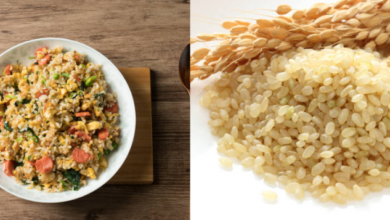Wheat or brown rice? uncover the truth behind the grain deception!
What To Know
- Brown rice is a good source of fiber, vitamins, and minerals, while wheat is higher in carbohydrates and gluten.
- While brown rice and wheat are not interchangeable, you can experiment with using brown rice flour or cooked brown rice in some recipes as an alternative.
- Can I eat brown rice if I have a wheat allergy.
Brown rice, a staple food for many, has been the subject of a persistent misconception: is it made of wheat? To dispel this confusion, let’s embark on a thorough investigation, separating fact from fiction.
The True Composition of Brown Rice
Brown rice is a whole grain derived from the Oryza sativa plant, belonging to the grass family. It is neither made of wheat nor contains any wheat components. The primary constituents of brown rice include:
- Bran: The outer layer, rich in fiber, vitamins, and minerals.
- Germ: The nutrient-dense core, containing healthy fats, protein, and vitamins.
- Endosperm: The inner portion, composed mainly of carbohydrates and proteins.
Wheat: A Distinct Grain
Wheat, on the other hand, is a cereal grain from the Triticum genus. It is genetically different from rice and has its own unique nutritional profile. Wheat contains:
- Starch: The primary carbohydrate source.
- Gluten: A protein that provides elasticity and structure to dough.
- Fiber: Found in the outer bran layer.
- Vitamins and minerals: Including B vitamins, iron, and zinc.
Key Differences Between Brown Rice and Wheat
To further clarify the distinction, let’s highlight the key differences between brown rice and wheat:
- Botanical Origin: Brown rice comes from the Oryza sativa plant, while wheat originates from the Triticum genus.
- Gluten: Brown rice is naturally gluten-free, whereas wheat contains gluten.
- Nutritional Profile: Brown rice is a good source of fiber, vitamins, and minerals, while wheat is higher in carbohydrates and gluten.
- Culinary Uses: Brown rice is typically cooked as a whole grain, while wheat is used in various forms, including flour, pasta, and bread.
Debunking the Confusion
The misconception that brown rice is made of wheat likely stems from their similar appearance. Both grains can have a brownish color, especially when whole grain or unprocessed. However, their distinct botanical origins and nutritional compositions make them entirely different grains.
Health Benefits of Brown Rice
Brown rice is a nutritious whole grain that offers several health benefits:
- Rich in Fiber: Supports digestive health, lowers cholesterol levels, and promotes satiety.
- Good Source of Nutrients: Contains vitamins, minerals, and antioxidants that support overall well-being.
- May Reduce Risk of Chronic Diseases: Studies suggest that consuming whole grains, including brown rice, may be associated with a lower risk of certain chronic diseases, such as heart disease and type 2 diabetes.
Final Note: Settling the Debate
In conclusion, brown rice is not made of wheat. It is a distinct whole grain with its own unique nutritional profile and health benefits. By understanding the differences between these two grains, we can make informed choices about the foods we consume.
Frequently Asked Questions
Q: Is brown rice gluten-free?
A: Yes, brown rice is naturally gluten-free.
Q: Can I substitute brown rice for wheat in recipes?
A: While brown rice and wheat are not interchangeable, you can experiment with using brown rice flour or cooked brown rice in some recipes as an alternative.
Q: Which grain is healthier, brown rice or wheat?
A: Both grains offer nutritional benefits, but brown rice is generally considered healthier due to its higher fiber content and absence of gluten.
Q: Is brown rice suitable for people with celiac disease?
A: Yes, brown rice is a safe and nutritious option for individuals with celiac disease.
Q: Can I eat brown rice if I have a wheat allergy?
A: Yes, people with wheat allergies can safely consume brown rice.
